Sijie Mai
Beyond Cosine Similarity Magnitude-Aware CLIP for No-Reference Image Quality Assessment
Nov 13, 2025Abstract:Recent efforts have repurposed the Contrastive Language-Image Pre-training (CLIP) model for No-Reference Image Quality Assessment (NR-IQA) by measuring the cosine similarity between the image embedding and textual prompts such as "a good photo" or "a bad photo." However, this semantic similarity overlooks a critical yet underexplored cue: the magnitude of the CLIP image features, which we empirically find to exhibit a strong correlation with perceptual quality. In this work, we introduce a novel adaptive fusion framework that complements cosine similarity with a magnitude-aware quality cue. Specifically, we first extract the absolute CLIP image features and apply a Box-Cox transformation to statistically normalize the feature distribution and mitigate semantic sensitivity. The resulting scalar summary serves as a semantically-normalized auxiliary cue that complements cosine-based prompt matching. To integrate both cues effectively, we further design a confidence-guided fusion scheme that adaptively weighs each term according to its relative strength. Extensive experiments on multiple benchmark IQA datasets demonstrate that our method consistently outperforms standard CLIP-based IQA and state-of-the-art baselines, without any task-specific training.
Disentangling Bias by Modeling Intra- and Inter-modal Causal Attention for Multimodal Sentiment Analysis
Aug 07, 2025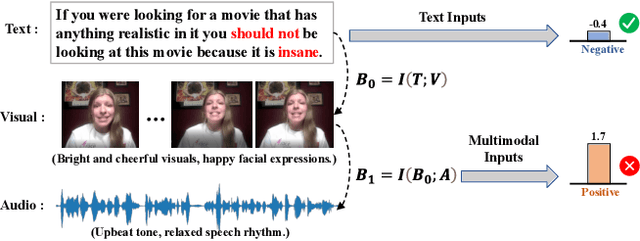
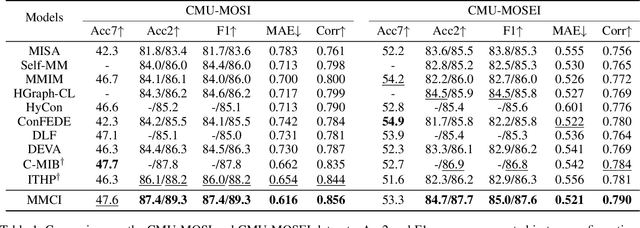
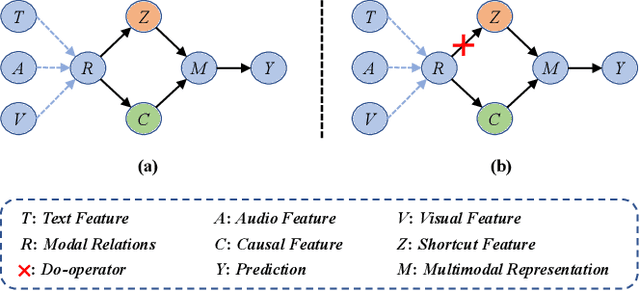
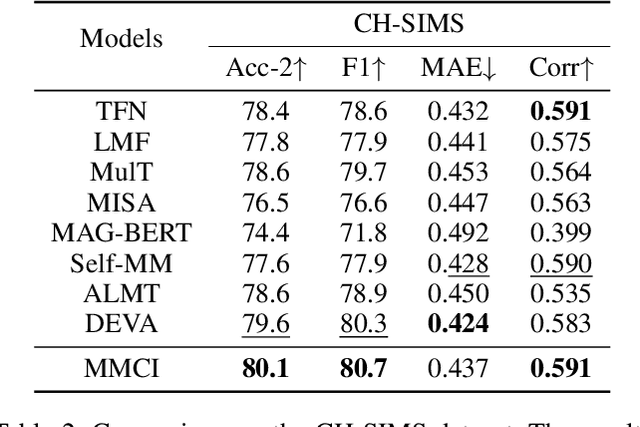
Abstract:Multimodal sentiment analysis (MSA) aims to understand human emotions by integrating information from multiple modalities, such as text, audio, and visual data. However, existing methods often suffer from spurious correlations both within and across modalities, leading models to rely on statistical shortcuts rather than true causal relationships, thereby undermining generalization. To mitigate this issue, we propose a Multi-relational Multimodal Causal Intervention (MMCI) model, which leverages the backdoor adjustment from causal theory to address the confounding effects of such shortcuts. Specifically, we first model the multimodal inputs as a multi-relational graph to explicitly capture intra- and inter-modal dependencies. Then, we apply an attention mechanism to separately estimate and disentangle the causal features and shortcut features corresponding to these intra- and inter-modal relations. Finally, by applying the backdoor adjustment, we stratify the shortcut features and dynamically combine them with the causal features to encourage MMCI to produce stable predictions under distribution shifts. Extensive experiments on several standard MSA datasets and out-of-distribution (OOD) test sets demonstrate that our method effectively suppresses biases and improves performance.
Towards Explainable Fusion and Balanced Learning in Multimodal Sentiment Analysis
Apr 16, 2025Abstract:Multimodal Sentiment Analysis (MSA) faces two critical challenges: the lack of interpretability in the decision logic of multimodal fusion and modality imbalance caused by disparities in inter-modal information density. To address these issues, we propose KAN-MCP, a novel framework that integrates the interpretability of Kolmogorov-Arnold Networks (KAN) with the robustness of the Multimodal Clean Pareto (MCPareto) framework. First, KAN leverages its univariate function decomposition to achieve transparent analysis of cross-modal interactions. This structural design allows direct inspection of feature transformations without relying on external interpretation tools, thereby ensuring both high expressiveness and interpretability. Second, the proposed MCPareto enhances robustness by addressing modality imbalance and noise interference. Specifically, we introduce the Dimensionality Reduction and Denoising Modal Information Bottleneck (DRD-MIB) method, which jointly denoises and reduces feature dimensionality. This approach provides KAN with discriminative low-dimensional inputs to reduce the modeling complexity of KAN while preserving critical sentiment-related information. Furthermore, MCPareto dynamically balances gradient contributions across modalities using the purified features output by DRD-MIB, ensuring lossless transmission of auxiliary signals and effectively alleviating modality imbalance. This synergy of interpretability and robustness not only achieves superior performance on benchmark datasets such as CMU-MOSI, CMU-MOSEI, and CH-SIMS v2 but also offers an intuitive visualization interface through KAN's interpretable architecture.
Meta-Learn Unimodal Signals with Weak Supervision for Multimodal Sentiment Analysis
Aug 28, 2024
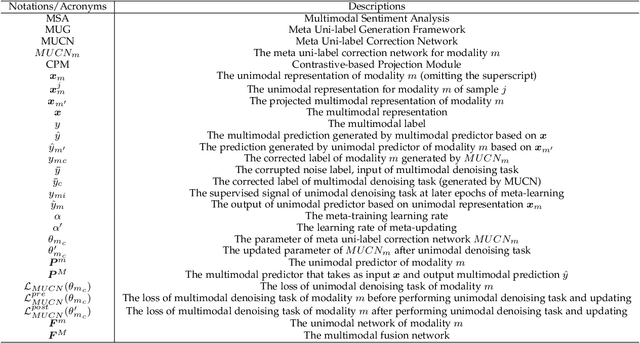
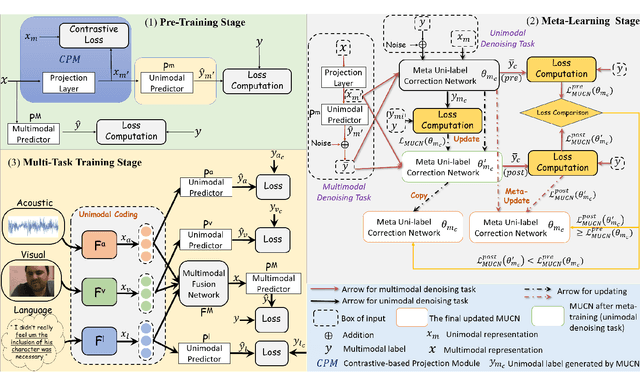
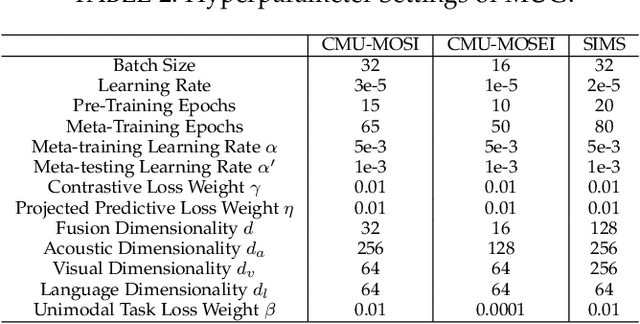
Abstract:Multimodal sentiment analysis aims to effectively integrate information from various sources to infer sentiment, where in many cases there are no annotations for unimodal labels. Therefore, most works rely on multimodal labels for training. However, there exists the noisy label problem for the learning of unimodal signals as multimodal annotations are not always the ideal substitutes for the unimodal ones, failing to achieve finer optimization for individual modalities. In this paper, we explore the learning of unimodal labels under the weak supervision from the annotated multimodal labels. Specifically, we propose a novel meta uni-label generation (MUG) framework to address the above problem, which leverages the available multimodal labels to learn the corresponding unimodal labels by the meta uni-label correction network (MUCN). We first design a contrastive-based projection module to bridge the gap between unimodal and multimodal representations, so as to use multimodal annotations to guide the learning of MUCN. Afterwards, we propose unimodal and multimodal denoising tasks to train MUCN with explicit supervision via a bi-level optimization strategy. We then jointly train unimodal and multimodal learning tasks to extract discriminative unimodal features for multimodal inference. Experimental results suggest that MUG outperforms competitive baselines and can learn accurate unimodal labels.
End-to-end Semantic-centric Video-based Multimodal Affective Computing
Aug 14, 2024Abstract:In the pathway toward Artificial General Intelligence (AGI), understanding human's affection is essential to enhance machine's cognition abilities. For achieving more sensual human-AI interaction, Multimodal Affective Computing (MAC) in human-spoken videos has attracted increasing attention. However, previous methods are mainly devoted to designing multimodal fusion algorithms, suffering from two issues: semantic imbalance caused by diverse pre-processing operations and semantic mismatch raised by inconsistent affection content contained in different modalities comparing with the multimodal ground truth. Besides, the usage of manual features extractors make they fail in building end-to-end pipeline for multiple MAC downstream tasks. To address above challenges, we propose a novel end-to-end framework named SemanticMAC to compute multimodal semantic-centric affection for human-spoken videos. We firstly employ pre-trained Transformer model in multimodal data pre-processing and design Affective Perceiver module to capture unimodal affective information. Moreover, we present a semantic-centric approach to unify multimodal representation learning in three ways, including gated feature interaction, multi-task pseudo label generation, and intra-/inter-sample contrastive learning. Finally, SemanticMAC effectively learn specific- and shared-semantic representations in the guidance of semantic-centric labels. Extensive experimental results demonstrate that our approach surpass the state-of-the-art methods on 7 public datasets in four MAC downstream tasks.
Curriculum Learning Meets Weakly Supervised Modality Correlation Learning
Dec 15, 2022



Abstract:In the field of multimodal sentiment analysis (MSA), a few studies have leveraged the inherent modality correlation information stored in samples for self-supervised learning. However, they feed the training pairs in a random order without consideration of difficulty. Without human annotation, the generated training pairs of self-supervised learning often contain noise. If noisy or hard pairs are used for training at the easy stage, the model might be stuck in bad local optimum. In this paper, we inject curriculum learning into weakly supervised modality correlation learning. The weakly supervised correlation learning leverages the label information to generate scores for negative pairs to learn a more discriminative embedding space, where negative pairs are defined as two unimodal embeddings from different samples. To assist the correlation learning, we feed the training pairs to the model according to difficulty by the proposed curriculum learning, which consists of elaborately designed scoring and feeding functions. The scoring function computes the difficulty of pairs using pre-trained and current correlation predictors, where the pairs with large losses are defined as hard pairs. Notably, the hardest pairs are discarded in our algorithm, which are assumed as noisy pairs. Moreover, the feeding function takes the difference of correlation losses as feedback to determine the feeding actions (`stay', `step back', or `step forward'). The proposed method reaches state-of-the-art performance on MSA.
Relation-dependent Contrastive Learning with Cluster Sampling for Inductive Relation Prediction
Nov 22, 2022



Abstract:Relation prediction is a task designed for knowledge graph completion which aims to predict missing relationships between entities. Recent subgraph-based models for inductive relation prediction have received increasing attention, which can predict relation for unseen entities based on the extracted subgraph surrounding the candidate triplet. However, they are not completely inductive because of their disability of predicting unseen relations. Moreover, they fail to pay sufficient attention to the role of relation as they only depend on the model to learn parameterized relation embedding, which leads to inaccurate prediction on long-tail relations. In this paper, we introduce Relation-dependent Contrastive Learning (ReCoLe) for inductive relation prediction, which adapts contrastive learning with a novel sampling method based on clustering algorithm to enhance the role of relation and improve the generalization ability to unseen relations. Instead of directly learning embedding for relations, ReCoLe allocates a pre-trained GNN-based encoder to each relation to strengthen the influence of relation. The GNN-based encoder is optimized by contrastive learning, which ensures satisfactory performance on long-tail relations. In addition, the cluster sampling method equips ReCoLe with the ability to handle both unseen relations and entities. Experimental results suggest that ReCoLe outperforms state-of-the-art methods on commonly used inductive datasets.
Multimodal Information Bottleneck: Learning Minimal Sufficient Unimodal and Multimodal Representations
Nov 12, 2022Abstract:Learning effective joint embedding for cross-modal data has always been a focus in the field of multimodal machine learning. We argue that during multimodal fusion, the generated multimodal embedding may be redundant, and the discriminative unimodal information may be ignored, which often interferes with accurate prediction and leads to a higher risk of overfitting. Moreover, unimodal representations also contain noisy information that negatively influences the learning of cross-modal dynamics. To this end, we introduce the multimodal information bottleneck (MIB), aiming to learn a powerful and sufficient multimodal representation that is free of redundancy and to filter out noisy information in unimodal representations. Specifically, inheriting from the general information bottleneck (IB), MIB aims to learn the minimal sufficient representation for a given task by maximizing the mutual information between the representation and the target and simultaneously constraining the mutual information between the representation and the input data. Different from general IB, our MIB regularizes both the multimodal and unimodal representations, which is a comprehensive and flexible framework that is compatible with any fusion methods. We develop three MIB variants, namely, early-fusion MIB, late-fusion MIB, and complete MIB, to focus on different perspectives of information constraints. Experimental results suggest that the proposed method reaches state-of-the-art performance on the tasks of multimodal sentiment analysis and multimodal emotion recognition across three widely used datasets. The codes are available at \url{https://github.com/TmacMai/Multimodal-Information-Bottleneck}.
Communicative Subgraph Representation Learning for Multi-Relational Inductive Drug-Gene Interaction Prediction
May 12, 2022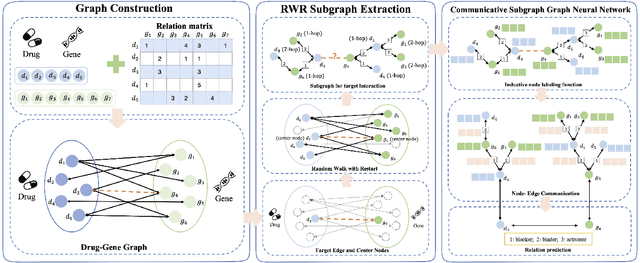
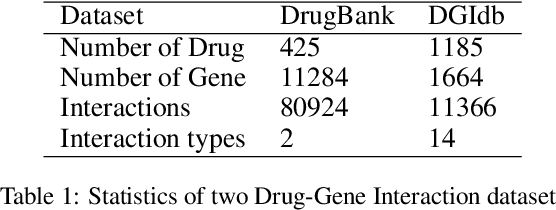
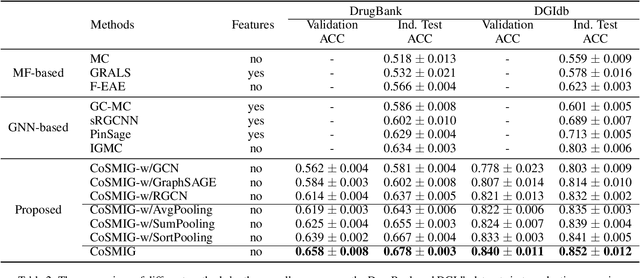
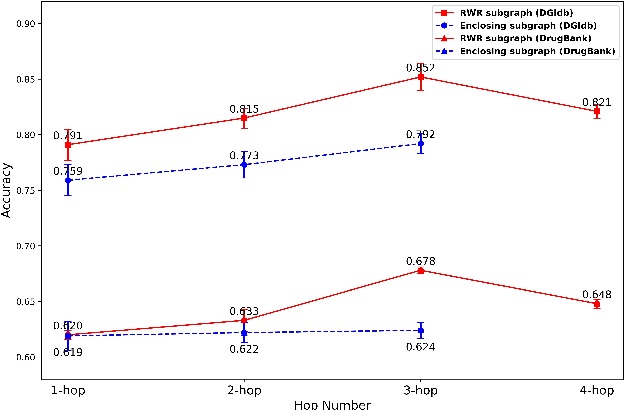
Abstract:Illuminating the interconnections between drugs and genes is an important topic in drug development and precision medicine. Currently, computational predictions of drug-gene interactions mainly focus on the binding interactions without considering other relation types like agonist, antagonist, etc. In addition, existing methods either heavily rely on high-quality domain features or are intrinsically transductive, which limits the capacity of models to generalize to drugs/genes that lack external information or are unseen during the training process. To address these problems, we propose a novel Communicative Subgraph representation learning for Multi-relational Inductive drug-Gene interactions prediction (CoSMIG), where the predictions of drug-gene relations are made through subgraph patterns, and thus are naturally inductive for unseen drugs/genes without retraining or utilizing external domain features. Moreover, the model strengthened the relations on the drug-gene graph through a communicative message passing mechanism. To evaluate our method, we compiled two new benchmark datasets from DrugBank and DGIdb. The comprehensive experiments on the two datasets showed that our method outperformed state-of-the-art baselines in the transductive scenarios and achieved superior performance in the inductive ones. Further experimental analysis including LINCS experimental validation and literature verification also demonstrated the value of our model.
Which is Making the Contribution: Modulating Unimodal and Cross-modal Dynamics for Multimodal Sentiment Analysis
Nov 10, 2021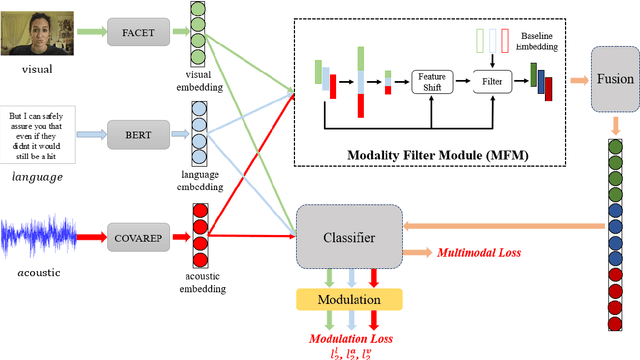
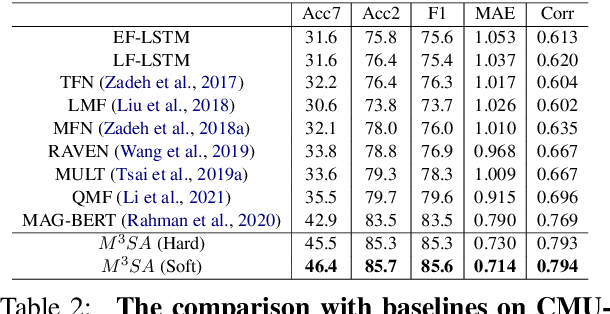
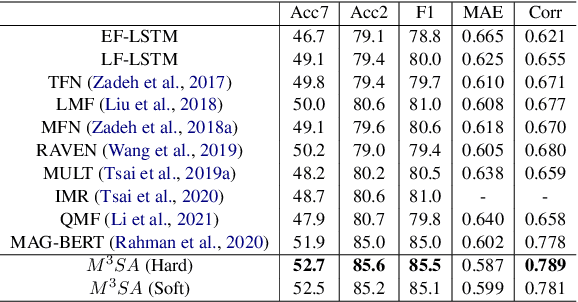
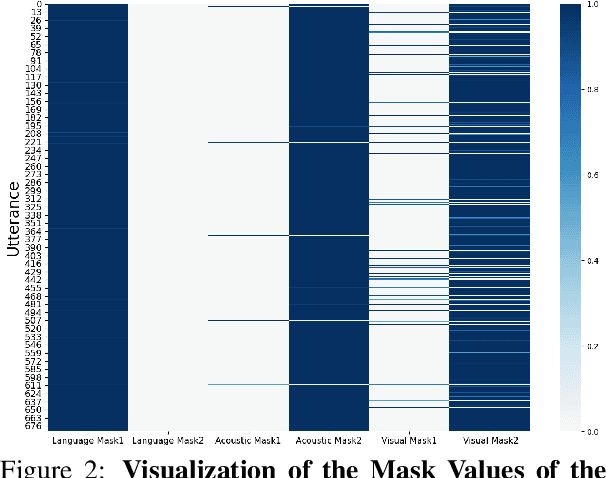
Abstract:Multimodal sentiment analysis (MSA) draws increasing attention with the availability of multimodal data. The boost in performance of MSA models is mainly hindered by two problems. On the one hand, recent MSA works mostly focus on learning cross-modal dynamics, but neglect to explore an optimal solution for unimodal networks, which determines the lower limit of MSA models. On the other hand, noisy information hidden in each modality interferes the learning of correct cross-modal dynamics. To address the above-mentioned problems, we propose a novel MSA framework \textbf{M}odulation \textbf{M}odel for \textbf{M}ultimodal \textbf{S}entiment \textbf{A}nalysis ({$ M^3SA $}) to identify the contribution of modalities and reduce the impact of noisy information, so as to better learn unimodal and cross-modal dynamics. Specifically, modulation loss is designed to modulate the loss contribution based on the confidence of individual modalities in each utterance, so as to explore an optimal update solution for each unimodal network. Besides, contrary to most existing works which fail to explicitly filter out noisy information, we devise a modality filter module to identify and filter out modality noise for the learning of correct cross-modal embedding. Extensive experiments on publicly datasets demonstrate that our approach achieves state-of-the-art performance.
 Add to Chrome
Add to Chrome Add to Firefox
Add to Firefox Add to Edge
Add to Edge